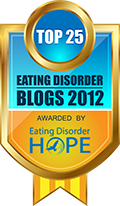The Devil in the Details
New research on people with body dysmorphic disorder shows that their brains focus on the details of their faces, rather than taking in the face as a whole. The study, titled "Abnormalities of Visual Processing and Frontostriatal Systems in Body Dysmorphic Disorder," was published in the most recent issue of Archives of General Psychiatry.* CNN covered the story, an excerpt of which is below:
It turns out that people with this condition have abnormal brain function when it comes to looking at pictures of their own faces, according to a new study led by Feusner and published in the Archives of General Psychiatry.What is especially interesting are the similarities between BDD and anorexia. Similar to what this study found in people with BDD, previous research has found that people with anorexia tend to focus on the details, which leads to a trait known as Weak Central Coherence (Southgate, Tchanturia, and Treasure, 2008). People with AN also show abnormalities in neural functioning when looking at images of themselves, but not other people (Sachdev et al, 2008).
When viewing themselves in photographs, patients with BDD underutilize parts of the brain used in seeing the face's overall shape and size, he said.
"If you just see the pieces of your face, and not seeing how they fit into the whole, then it's going to look distorted," he said. "That's how we interpret the findings."
More from the CNN story:
"...the part of the brain that helps guide behavior and maintain emotional flexibility, the frontostriatal systems, had unusual activation patterns.Considering that people with BDD show many of the same difficulties in executive functioning (i.e., "a loosely defined collection of brain processes which are responsible for planning, cognitive flexibility, abstract thinking, rule acquisition, initiating appropriate actions and inhibiting inappropriate actions, and selecting relevant sensory information.") as people with AN, perhaps the underlying neurological similarities shouldn't be surprising.
"What we think may be happening is that they may be seeing details, perhaps even seeing details normally, but that they're not able to contextualize it," [Fuesner] said...The study is "groundbreaking" in its demonstration that patients with BDD are too focused on the details aren't able to see the whole picture when they see themselves, said Sabine Wilhelm, director of the BDD Clinic and Research Unit at Massachusetts General Hospital, who was not involved in the study. This can be observed anecdotally in treatment, but this study confirms it at the level of brain processing, she said.
Feusner's previous research found that when BDD patients viewed the faces of other people -- not their own faces -- the brain's left hemisphere, associated with categorization and details, was more more active. Healthy individuals used the right hemisphere, the part of brain that processes more holistically.
It is too early to directly apply the findings to treatment, but one possibility is that patients with BDD could be retrained to see their own faces, he said.
The Semel Institute at UCLA is currently recruiting subjects for a study to compare neural processing in people with BDD, people with AN, and healthy controls. Click here for more information- I will phone the study site tomorrow as I am interested in participating and I will post more information as I get it.
*I haven't yet been able to get ahold of the full-text of this study- my alumni association dues need to be updated before I can get a copy, so I apologize.






3 comments:
hmm... How much can we bet that those with ED are now going to have the BDD tacked onto their diagnosis' ??
I hope the above commenter is wrong because not all of us HAVE BDD (I know you know that Carrie, I am just speaking up for the other side!). I didn't, if I had to link my anorexia to another disorder it would have to be OCD. I didn't try to lose weight because I thought I was fat, it was because I associated weight loss with safety. Anyone attempting to prove that I have BDD just by virtue of my history with anorexia would be very confused!
I do understand that an awful lot of people with eating disorders also have symptoms of BDD though so it'll be interesting to see the results of this study eventually :)
Allegri,
Actually, the diagnostic criteria for BDD specifically exclude the body dysmorphia associated with AN. You can have both, yes, but the standard feelings of fatness that accompany AN are not cause for a BDD diagnosis.
Katie,
I don't think the two disorders are the same, either, but it will be interesting to see what similarities there are.
Post a Comment